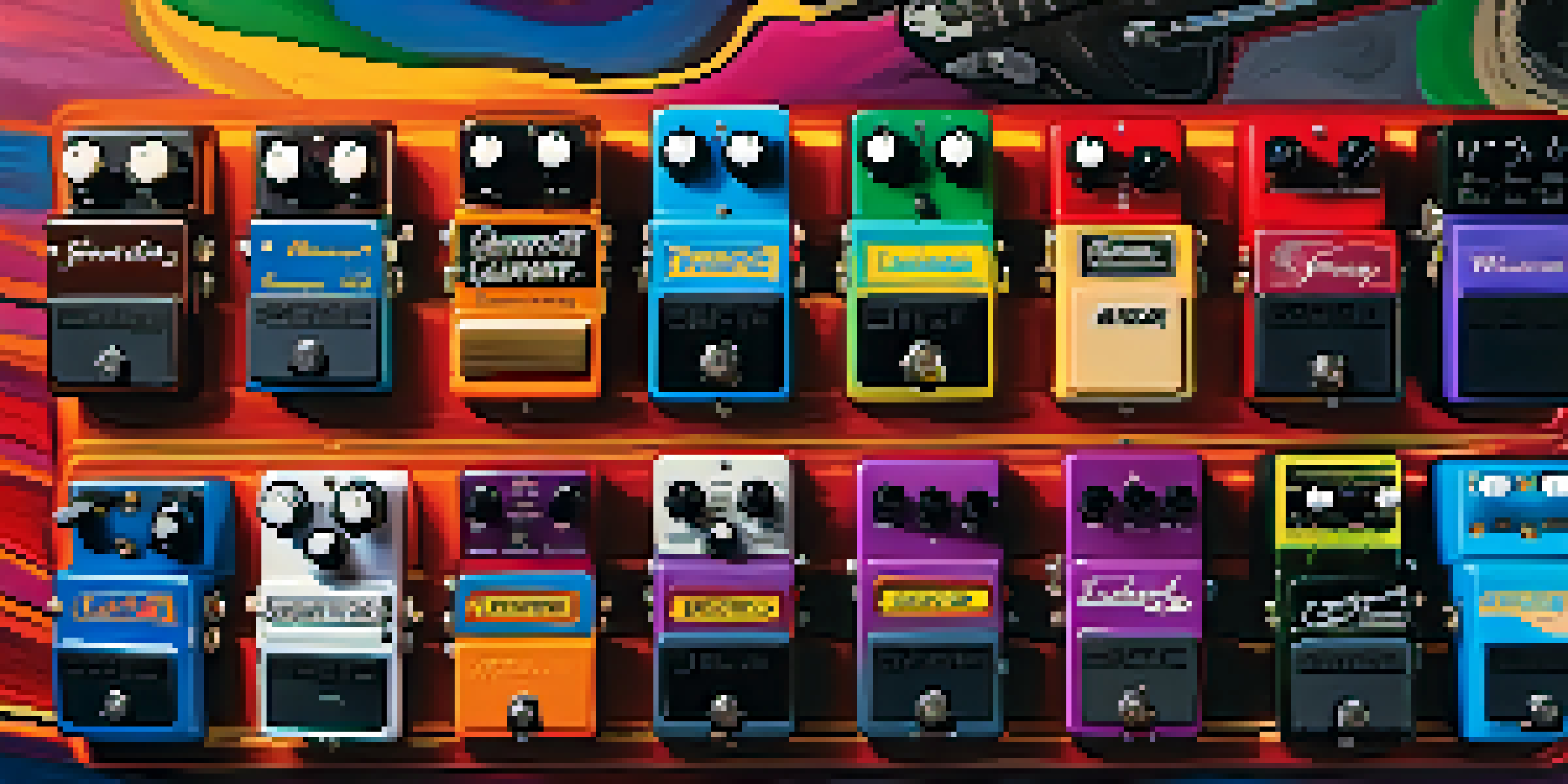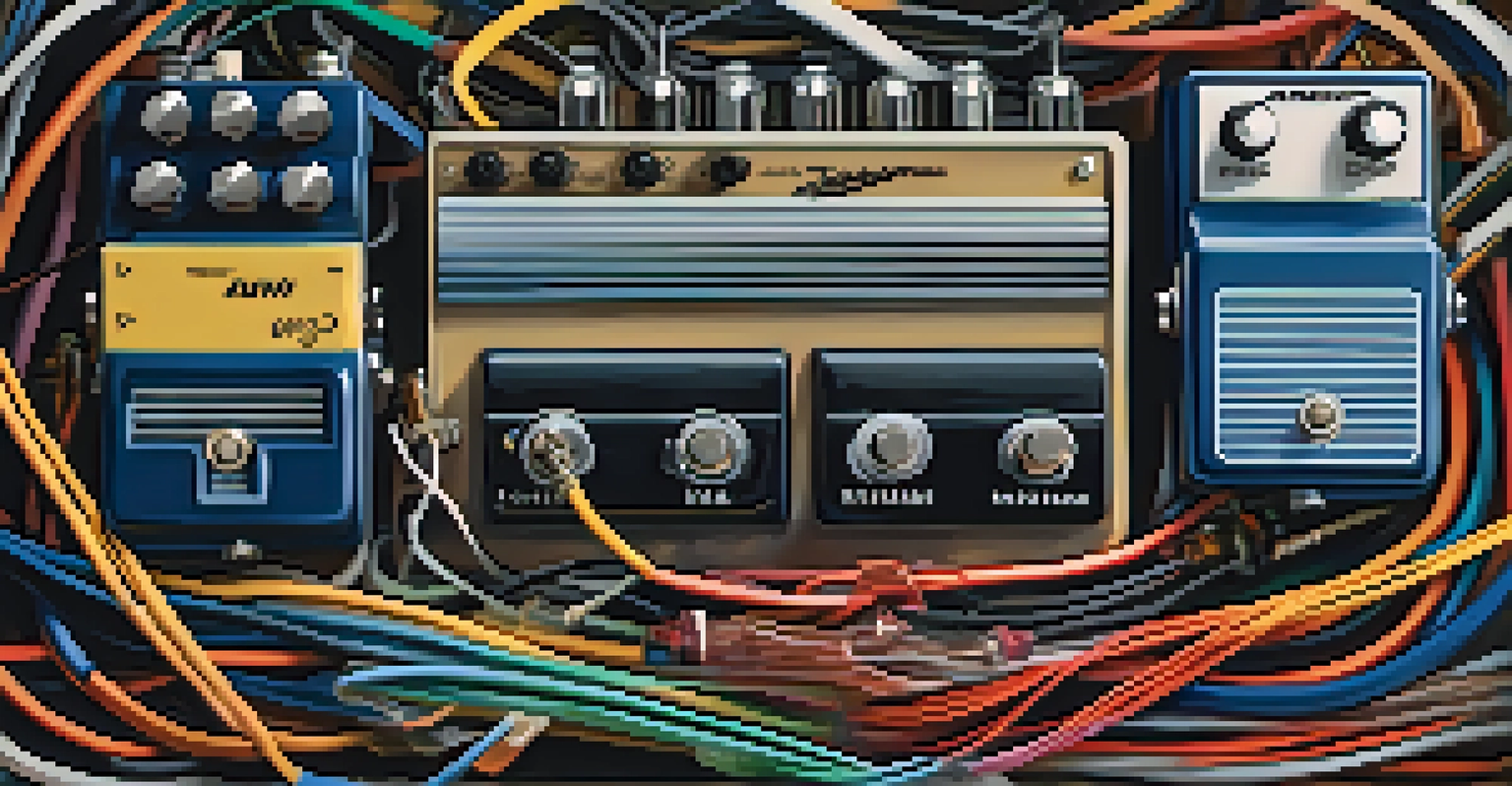Exploring Guitar Pedals: Crafting Your Unique Soundscape

Understanding Guitar Pedals: The Basics
Guitar pedals are essential tools for shaping your sound. They allow musicians to modify the tone of their instrument, adding effects like reverb, distortion, and delay. Each pedal serves a specific purpose, making it important to understand their functions before diving in.
Music is the shorthand of emotion.
Think of guitar pedals as the spice cabinet for your sound. Just like a pinch of salt can enhance a meal, the right pedal can elevate your music. With countless options available, it can be overwhelming, but starting with the basics will help you build a solid foundation.
As you explore different pedals, you'll discover how they interact with each other. This interaction can create unique effects that define your personal sound. Embracing this experimentation is key to finding the right combination that resonates with your style.
Types of Guitar Pedals: A Quick Overview
There are several types of guitar pedals, each offering distinct effects. Distortion pedals, for instance, are known for adding grit and sustain, making them popular in rock music. Conversely, modulation pedals can create lush, swirling sounds, perfect for adding depth to your playing.

Delay and reverb pedals are great for creating space in your sound. Delay allows you to repeat notes, adding layers and complexity, while reverb simulates natural acoustic environments, enhancing the overall atmosphere of your music. Each type has its unique charm, contributing to your sonic palette.
Guitar Pedals Enhance Your Sound
Guitar pedals are essential tools that modify your instrument's tone, adding effects like reverb and distortion.
Understanding the characteristics of different pedals will help you make informed choices. Whether you're seeking a punchy sound or a dreamy vibe, knowing what each pedal does is crucial in crafting your sonic identity.
Choosing Your First Pedal: Tips for Beginners
When starting your pedal collection, it’s wise to choose one that aligns with your musical style. If you’re into rock, a distortion pedal might be your best bet. For those who prefer atmospheric sounds, consider a delay or reverb pedal to add texture to your music.
The beautiful thing about learning is that no one can take it away from you.
Budget is another important factor. Fortunately, there are quality pedals available at various price points. It’s not always about spending a fortune; many affordable options can deliver fantastic sounds, allowing you to explore without breaking the bank.
Lastly, don’t hesitate to try before you buy. Visiting a local music store can provide invaluable hands-on experience. Testing pedals in a live setting will help you understand how they interact with your guitar and amp, ensuring the best fit for your sound.
Experimenting with Pedal Combinations
Once you have a few pedals, it’s time to get creative with combinations. Layering effects can lead to intriguing sounds that define your musical style. For example, combining a distortion pedal with a delay can produce a powerful, echoing tone that resonates beautifully.
Think of this process as painting a canvas. Each pedal adds its own color and texture, allowing you to build a unique soundscape. Experimentation is key; don’t be afraid to mix and match to discover what works best for you.
Experiment with Pedal Combinations
Combining different pedals can create unique sounds, allowing you to define your musical style through experimentation.
Document your favorite combinations and settings. This way, you can recreate your signature sounds easily. Over time, you'll develop a deeper understanding of how different pedals interact, paving the way for even more exploration in your sonic journey.
Understanding Signal Chain: How to Arrange Your Pedals
The order in which you place your pedals significantly affects your sound. Generally, distortion pedals should be placed before modulation effects, as this allows for a clearer signal. Reverb and delay typically go at the end of the chain, creating a spacious atmosphere.
Visualize your pedalboard as a pathway for your sound. Each pedal influences the signal as it travels, much like how ingredients blend in a recipe. Getting the order right is essential for achieving the desired effect.
Experimenting with your signal chain can yield surprising results. Sometimes, switching the order can create a whole new sound. Don’t hesitate to rearrange your pedals and see what new textures you can create!
Maintaining Your Pedals: Best Practices
Taking care of your pedals is crucial for longevity and performance. Regularly check the connections and cleaning the jacks can prevent issues and ensure optimal sound quality. A simple maintenance routine can save you from future headaches.
Storing your pedals properly is another important aspect. Keeping them in a climate-controlled environment can prevent damage, especially from humidity or extreme temperatures. Consider investing in a pedalboard bag for safe transport to gigs or rehearsals.
Proper Maintenance is Key
Taking care of your pedals through regular maintenance and proper storage ensures longevity and optimal performance.
Lastly, be mindful of your power supply. Using the wrong voltage can damage your pedals. Always check the specifications and consider using a power supply designed specifically for pedals to avoid any mishaps.
Finding Your Unique Sound: The Journey Ahead
As you delve into the world of guitar pedals, remember that finding your unique sound is a journey, not a destination. Embrace the process of exploration and experimentation. Each pedal you add to your collection will bring you closer to discovering your musical identity.
Don’t be afraid to step outside your comfort zone. Trying new effects and combinations can lead to unexpected creative breakthroughs. Sometimes, the most memorable sounds come from taking risks and playing with your gear.

Ultimately, the goal is to express yourself authentically through your music. Your sound is a reflection of who you are as an artist. So, enjoy the adventure of crafting your unique soundscape and let your creativity shine!